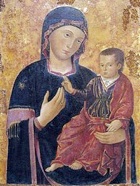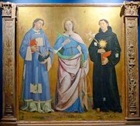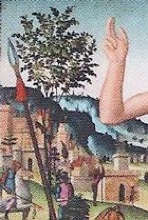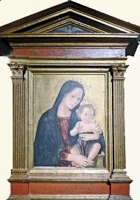Antonio di Benedetto Aquilo degli Aquili, who is better known as Antoniazzo Romano, was one of the three Consuls of the Compagnia di San Luca, the guild of painters working in Rome that Pope Sixtus IV approved in 1478. He was the only major Roman among its founder members: the only other artists named in the first membership list whose fame has survived were two men who had been born elsewhere:
-
✴Melozzo da Forli (see below); and
-
✴the young Antonio del Massaro da Viterbo, il Pastura.
In the absence of an established Roman school of artists, the Renaissance popes largely relied on painters fro Florence and central Italy for the great commissions that began after their return from Avignon. Antoniazzo Romano was able to learn from them. He seems to have worked on the frescoes of the Biblioteca Vaticana under Domenico Ghirlandaio in 1475, and he was documented here again, 1480-81, when he was working under Melozzo da Forli. This latter interaction seems to have been particularly important for his stylistic development. He was documented in 1484 as an associate of Perugino in relation to some decorative projects in the Vatican Palace in preparation for the coronation of Pope Innocent VIII; in 1485 as an associate of Pier Matteo d’ Amelia; and in 1492 with both Perugino and Pier Matteo d’ Amelia in relation to the preparations made for the coronation of Pope Alexander VI in 1492.
His earliest known major commission was for the frescoes (1464-7) in the funerary chapel of the Cardinal Bessarion next to Santi Apostoli, which have recently been partially recovered from under plaster. An indication of his emerging status as an independent artist is the fact that the Opera del Duomo invited Antoniazzo Romano to Orvieto to complete the decoration of the Cappella Nuova there, but he declined. In 1493, Cardinal Oliviero Caraffa selected him to value the frescoes that he had commissioned for his chapel in Santa Maria sopra Minerva from Filippino Lippi: in his “Life” of Lippi, Giorgio Vasari mentions that Antoniazzo Romano was one of the two best painters in Rome at that time.
The earliest surviving signed work by Antoniazzo Romano is a panel (1464) of the Madonna and Child from Sant’ Antonio del Monte, Rieti, which is now in the Museo Civico there. His surviving works in Rome include:
-
✴a panel (ca. 1488) of the Madonna and Child with SS Peter and Paul and the twelve members of the Curial Rota, which Bishop Giovanni Cerretani of Nocera Umbra, who was Auditor of the Rota, provided for in his will of 1488 and which is now in the Pinacoteca Vaticana; and
-
✴a signed panel (1500) of the Annunciation, which Cardinal Juan de Torquemada commissioned for the altar of the Confraternita dell’ Annunziata (which he had founded) in Santa Maria sopra Minerva, in which he presents poor girls dowered by the confraternity to the Virgin.
The last known documentary record of Antoniazzo Romano the will that he wrote as he approached death in 1508, which shows that he had achieved considerable material success. His large workshop included his son, Marcantonio Aquili (died after 1526) and his nephew, Evangelista Aquili (died after 1524).
The artistic activity of Antoniazzo Romano seems to have been confined to Rome and Lazio, but a few panels that seem to be autograph works found their way to Umbria (see below). His followers included the Umbrian Pancrazio Jacovetti da Calvi, and his son and nephew each worked in minor Umbrian towns.
Copies of Marian Icons
In 1464, as noted above, Cardinal Bessarion commissioned frescoes from Antoniazzo Romano for his funerary chapel next to SS Apostoli. This project included a panel (ca. 1470) of the Madonna and Child that is now in the Cappella di Sant, Antonio, SS Apostoli. It is a copy of a possibly Byzantine icon of the Theotokos (Mary, Mother of God) in Santa Maria in Cosmedin, one of the Greek churches in Rome.
Alessandro Sforza, lord of Pesaro is known to have commissioned copies of two important Marian icons in Rome. These copies are both lost, but they apparently had inscriptions that identified Sgorza as the donor and provided further information:
-
✴Antoniazzo da Romano had painted a copy of an ancient (possibly 6th century) icon of the Madonna and Child in Santa Maria Maggiore that is now known as the Salus Populi Romani (Protectress of the Roman People).
-
✴Melozzo da Forli had painted a copy of the icon of the Madonna and Child in Santa Maria del Popolo, which had probably been painted in Rome on a Byzantine model in the 13th century.
In each inscription, Alessandro Sforza insisted that the prototype had been painted by St Luke. The date at which he commissioned the copies is uncertain: most sources suggest 1461, when he spent the early months in Rome. However, a more likely period is between 1469, when he entered the military service of Pope Paul II, and 1473, when he died. (Like Cardinal Bessarion, Paul II was passionately interested in Byzantine culture and specifically in the cult of icons).
Antoniazza Romano was the Treasurer of the Confraternita del Gonfalone, the confraternity that acted as the custodian of the icon in Santa Maria Maggiore, in 1470. The production of panels based on this and other venerated Marian icons in Rome seems to have been one of his specialities, serving a market promoted not only by Paul II but also by his successor, Pope Sixtus IV. Surviving examples of this genre that are by or attributed to Antoniazza Romano include:
-
✴a signed panel (1486) from the Duomo, Velletri, now in the Museo Diocesano there, which seems to be a copy of the icon in Sant’ Agostino, Rome (which Clement of Toscanella, who gave it to the church in 1482, claimed had been saved from Hagia Sophia when Byzantium fell to the Turks, although over-painting makes this difficult to verify);
-
✴a panel (attributed, 15th century) of the Virgin interceding for Pope Leo I after he had cut off his own hand after he had been tempted when a woman kissed it, which is now in the National Gallery, Dublin, in which the Virgin might have been copied from what was believed to be the actual icon of the “Madonna Avvocata” (interceding Virgin) in Santa Maria Maggiore that had interceded for Leo I (see below); and
-
✴a panel (attributed, 15th century) that was in the Charles Loeser Collection, Florence until 1959, which is another copy of the icon in Santa Maria del Popolo.
The attribution of the panel (ca. 1470) of the Madonna and Child in Montefalco that is discussed below should be considered in this context.
[Note that the presence of an icon of the Madonna Avvocata in Santa Maria Maggiore is conjectural: if it existed, it has been lost. However, similar icons certainly existed in other churches: the following link leads to a page that illustrates some of the icons of the “Madonna Avvocata” that survive in Rome. The oldest and most important of these is the last in this webpage, which is now in the chapel of the Dominican nunnery of Santa Maria del Rosario, Rome.]
Amelia
Madonna and Child (15th century)

[Previously in the right transept of the Duomo: where is it now?]
Montefalco
Madonna and Child (ca. 1470)
The panel in Montefalco is generally dated in relation to the (now lost) copy of this icon that Alessandro Sforza, lord of Pesaro commissioned from Melozzo da Forli in ca. 1470 (see above). There is some debate about its attribution:
-
✴It is usually thought, on stylistic ground, to be another copy by Melozzo da Forli or his workshop.
-
✴However, yet another copy of the icon that was in the Charles Loeser Collection, Florence until 1959 is generally attributed to Antoniazzo Romano, who was a prolific painter of this kind of image (as set out in the page on this artist). Federico Zeri attributed the panel in Montefalco to him.
-
✴Laura Teza has recently suggested, on stylistic ground, that it is by the Perugian, Bartolomeo Caporali, who was documented in Rome in 1467 among the artists working for Pope Paul II at the Chiesa di San Marco (as referenced in the page on this artist).
[The image in this Hungarian website has obvious relevance to the debate, but I have not been able to find out anything else about it.]
Three Saints (ca. 1488)

The altarpiece depicts three saints who are identified by inscription as SS Vincent of Saragossa, Illuminata and Nicholas of Tolentino. Recent restoration has shown that these inscriptions are not original and that:
-
✴the central figure of “Sant’ Illuminata” originally had a wheel (later over-painted but revealed in the restoration), and so had been adapted from an image of St Catherine of Alexandria: and
-
✴“St Nicholas of Tolentino” originally had a Franciscan habit that had been over-painted, and so had been adapted from an image of a Franciscan, probably St Antony of Padua.
This over-painting was almost certainly done at the time that the panel was transferred to Montefalco.
The presence of St Catherine of Alexandria at the centre of the composition suggests that the altarpiece was painted for an altar dedicated to her. The Portuguese Cardinal Jorge Costa, who had bought the Cappella di Santa Caterina in Santa Maria del Popolo from Cardinal Domenico della Rovere in 1488, almost certainly commissioned it: this probably accounts for the presence of two Iberian saints (SS Vincent of Saragossa and Antony of Padua). The panel was probably transferred to Montefalco after the death of Cardinal Costa in 1508.
Narni
Resurrection (15th century)


This damaged but recently restored panel in the Pinacoteca was documented in the ownership of the Istituto Beata Lucia di Narni in 1872, in 1872, but nothing is known of its original location. It seems to have been painted for a location in Narni: the cityscape to the left apparently represents the Rocca di Narni (at the extreme left), Porta Ternana (to the left of the spear) and presumably a gate that existed in the 16th century in front of the Arco Romano. The Institute still owns the panel, but it has allowed it to be displayed as part of the civic collection of Narni since 1969.
Marcantonio Aquili used a very similar composition for the central panel of a signed triptych (1511) for Santa Chiara, Rieti, which is now in the Museo Civico there. For this reason, the panel in Narni was also traditionally attributed to him. However, following its restoration, it is now attributed to his father, Antoniazzo Romano, whose cartoons Marcantonio habitually used. (This article in La Pagina describes the circumstances in which the new attribution was made).
Perugia
Madonna and Child (15th century)

Read more:
V. Tiberia, “Presenze Antoniazzesche e dei Torresani nell’ Umbria Meridionale”, in F. Baldelli (Ed.), “Piermatteo d'Amelia: Pittura in Umbria Meridionale fra '300 e '500”, Assisi (1997)
Return to Art in: Amelia Montefalco Narni Perugia.
Return to “Foreign” Painters in Umbria.



